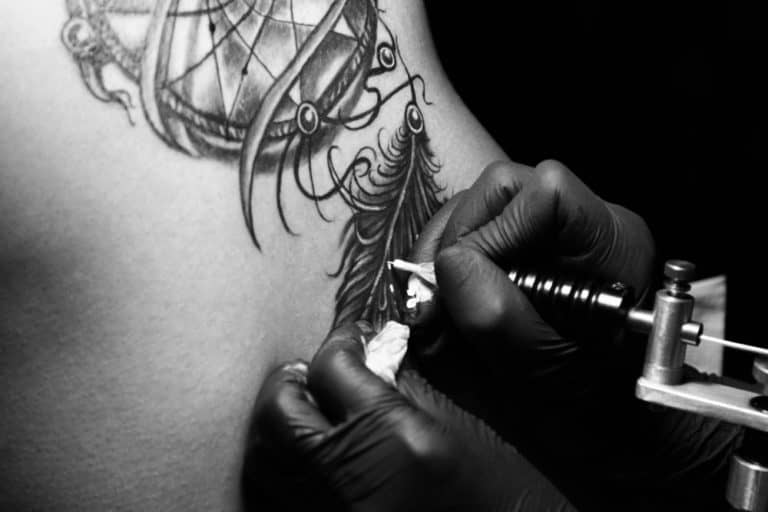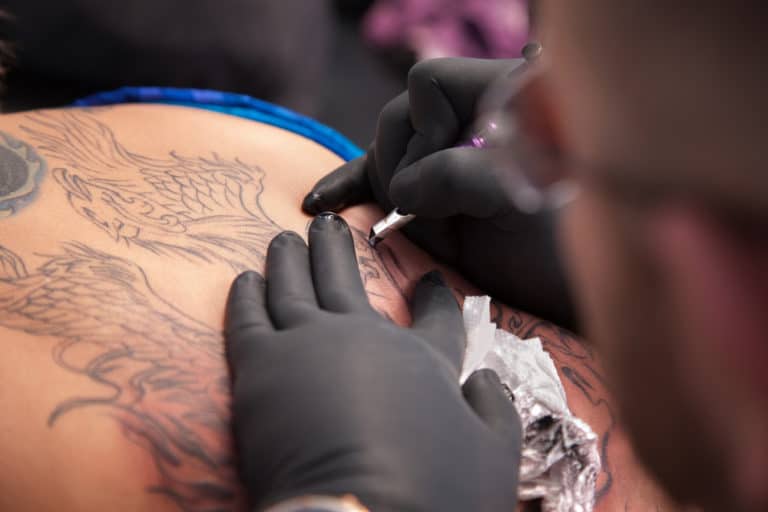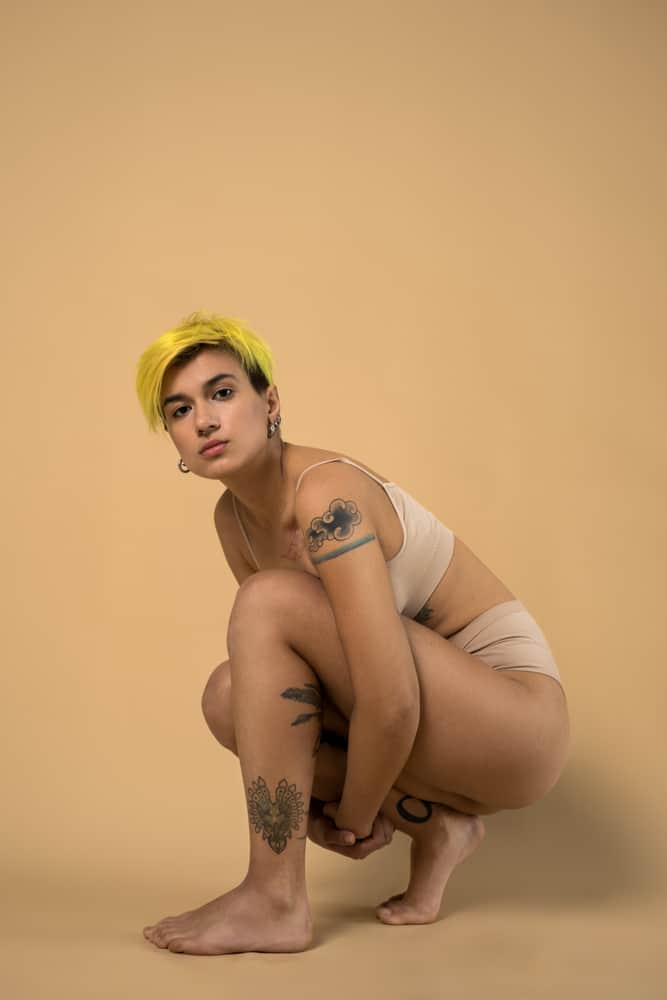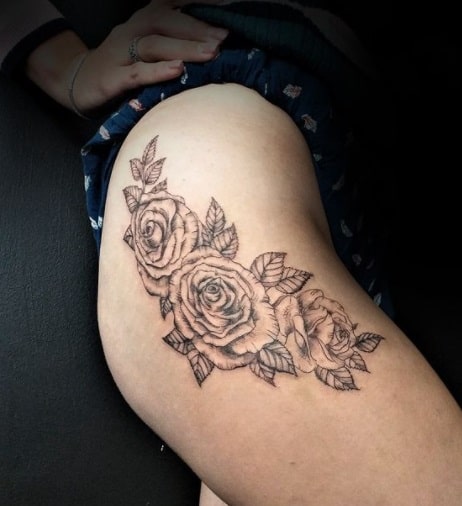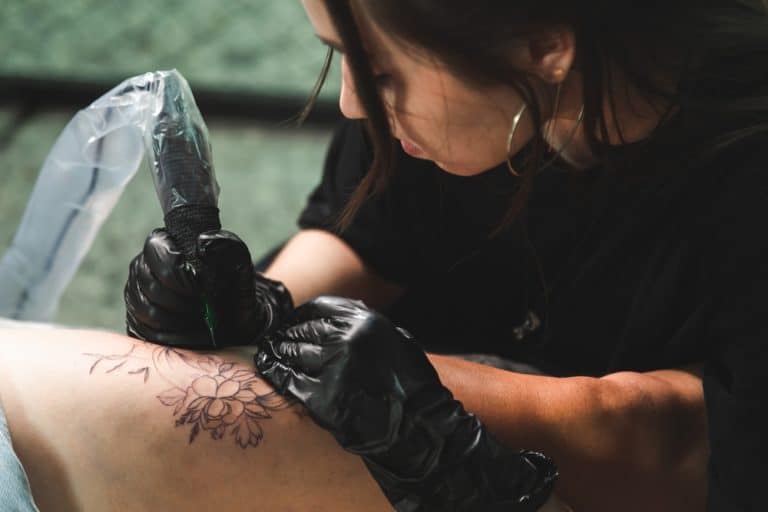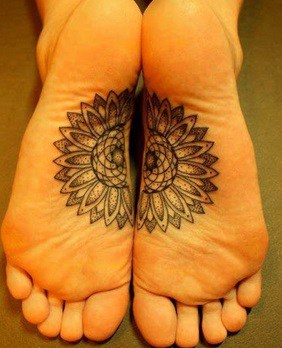Calf Tattoos (Everything You Need To Know)
Once the preserve of racy Victorian ladies, calf tattoos have become popular with athletic guys who highlight their calf muscles with tribal designs. Calf tattoos can be hidden at the office, displayed comfortably over weekends, and increasingly socially acceptable. If you’re keen on having ink on your calf, doing your homework is essential.
Calf tattoos are popular as they’re some of the least painful areas to ink, have a large surface area, and have positive symbolism. The cost will depend on the size and intricacy of the tattoo, as will the healing time. Calf tattoos take one to four months to heal, with appropriate aftercare.
Although calf tattoos are common, there’s a lot to learn before having one. You’ll need to consider the ideal design, source the perfect tattoo artist, and learn about caring for your tattoo, including when to start exercising, what to wear, and how to help a new tattoo heal. Read on to discover the ins and outs of calf tattoos.
Why Do People Get Calf Tattoos? (And Meaning)
The calf or the back of your lower leg is a popular tattoo location for many reasons. Let’s look at why people get calf tattoos and whether it’s a good choice for you.
Why Get A Tattoo?
If you’re already deciding where to place your tattoo, you likely already have good reasons why you want a tattoo. If you haven’t reflected on it yet, here’s why people get tattoos:
- Tattoos belong to an outsider art sub-culture, embraced by free spirits, rebels, and those seeking transformation. They’re not for conformists.
- Most tattoos express your unique and individual identity, whether to the world or as part of an intensely personal narrative. For example, you may want to commemorate overcoming a life challenge and embrace your resilience or keep an image of a loved one close.
- Your body can also be a canvas for communicating your beliefs. For instance, a tattoo can be a political statement, an expression of spiritual devotion, or a symbol of belonging.
- Tattoos are a form of body art and modification. Having a tattoo to decorate and beautify your body is deeply meaningful and liberating, particularly when it forms part of your cultural heritage.
- For some, the whole tattoo process is profound, including the design choice and the pain felt while being inked.
- Most people find that having a tattoo improves their self-esteem, often making them feel proud of and confident about their appearance. Tattoos generally attract attention and are a tool for exhibitionism.
- Having a tattoo as a rebellion, thrill, or risk-seeking behavior (especially while drunk or high) can cause regret. Tattoos are permanent and are ideally considered and undertaken thoughtfully.
Why Is The Calf An Ideal Tattoo Location?
Once permanently hidden by conservative fashion requirements, your calves are often visible to others, not merely for private viewing.
There are four reasons why the calf is the perfect place for a tattoo:
- The calf is one of the least painful areas of your body to tattoo.
- There is a lot of space on the calf, so you can have an extensive and intricate piece of art.
- A tattoo accentuates and draws attention to well-shaped, muscular calves.
- It’s relatively easy to hide a calf tattoo under jeans, trousers, leggings, or tights if you don’t want your body art to be visible.
Are Calf Tattoos For Men Or Women?
In the nineteenth century, calf tattoos were popular with women as they were unlikely to show their legs to anyone except their partner. Body art was for private pleasure.
Men began getting calf tattoos as trousers became shorter over the twentieth century. These fashion changes were associated with an increase in the wellness and exercise industry, as fitness, working out, and going to the gym became the norm. Calf tattoos were a great way of drawing attention to well-muscled legs.
Calf tattoos are once again catching on with women, especially as tattoos become more socially acceptable and as women embrace athleticism and athleisure wear.
What Does A Tattoo On The Calf Symbolize?
Tattoo location is not only about placement, symmetry, and visibility. Different tattoo locations, including the calf, are associated with types of spiritual energy.
Your calves represent motion, momentum, and progress. You may experience tension and carry negative emotions in your calves if you’ve encountered barriers or obstacles.
For a calf tattoo design, be inspired by your goals, what you’re working towards, and what kind of future you imagine for yourself.
Does It Hurt Getting A Calf Tattoo?
All tattoos are painful because the process involves repeatedly inserting a needle into the skin. However, how much pain you experience will depend on where the tattoo takes place and your pain threshold.
Your calf is one of the least painful areas to tattoo, as most of the work will be done on fatty, muscular areas with a thicker layer of skin. Because of limited nerve endings, the calf is not an extremely sensitive body part.
It is easy for the tattooist to reach your calf, and you can lie in a comfortable position while being inked. You can look away from the needle and blood if you’re sensitive.
Because you are unlikely to move around or flinch, and because the calf is a flattish area, the tattoo process will be less painful.
Pain levels are described as low to moderate, with mostly dull, background, and scratching pains experienced.
If your tattoo design extends round to the shinbone or toward the ankle bone. In that case, the pain level will increase dramatically. It is very uncomfortable to be inked on bony areas with thin skin and several nerve endings. You will feel vibrating, stinging pain.
A calf tattoo can also become more painful if you have a large piece done. The more intricate a tattoo, the longer it takes and the more discomfort you’ll have to endure.
Experienced, well-qualified tattoo artists will be happy to give you a break once your pain threshold has been reached.
How Much Does A Calf Tattoo Cost?
The price of a calf tattoo will be influenced by many factors and can range from a small, simple image at $100 to an intricate leg sleeve over $1,000.
However, it is best to consult your tattoo artist and get a fixed quote because tattoo costs depend on many factors:
- Size of the tattoo: Small tattoos (e.g., a single flower or symbol) will cost between $70 and $300; a medium-sized tattoo (e.g., an animal or cartoon figure) goes for $300 to $700; a large tattoo will go for $700 and up.
- Design: An intricate design that took the artist hours to create and hours to tattoo will be pricier than a simple pre-drawn flash (which you can choose at the studio).
- Time: Unless you have a really speedy artist, the longer an artist spends on your tattoo, the more it will cost. You can pay $100 to $250 per hour, so a tattoo that takes five hours can cost over $1000.
- Color: Highly detailed, colorful designs take longer and require several ink changes, so they will be more expensive.
- Artist’s skill and experience: An apprentice tattooist will be far cheaper than a highly experienced, talented artist.
- The popularity of artist and studio: If an artist or studio has become well-known, featured on a TV show, or inked celebrities, the price will rise astronomically.
Discuss the cost with the artist before the inking begins so that you’re both clear on expectations.
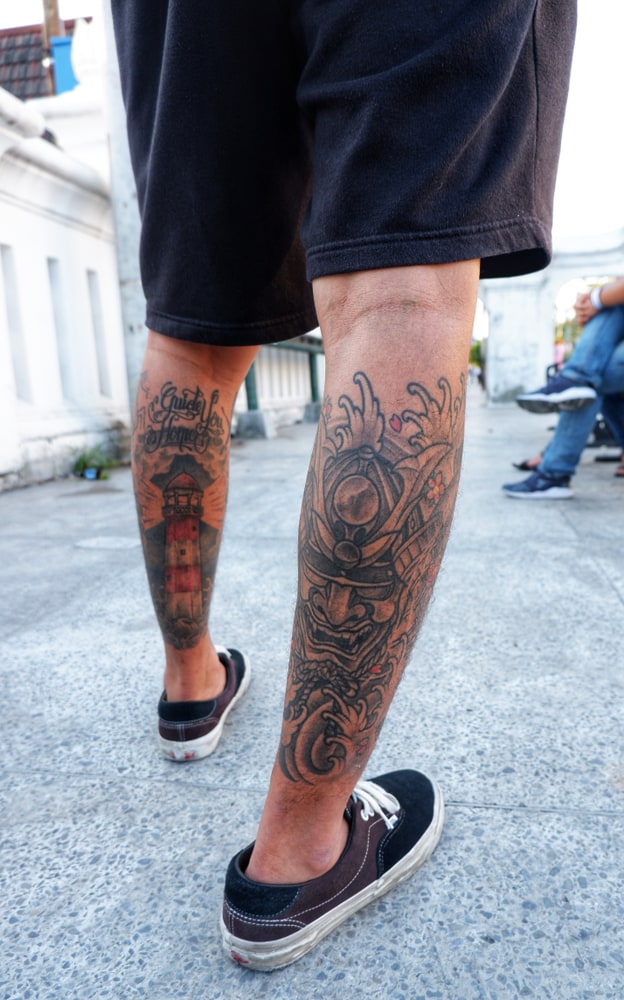
How Long Do Calf Tattoos Take To Heal?
Depending on size, your calf tattoo will take one to four months to heal completely. There are three stages in the tattoo healing process.
Inflammation (Days 1-3)
For the day of the tattoo and the next few days, you will experience the most pain and discomfort. The skin’s epidermis has been wounded and doesn’t recognize a tattoo as a decorative art.
Immediately after the needling process, the artist will cover the tattoo with a bandage or plastic film. If the cover is medical grade, leave it on for two days. Remove it after a couple of hours if it’s just plastic film.
Once the tattoo is exposed, wash it gently with antibacterial soap to remove blood and fluid. Pat it dry and apply a thin layer of the recommended lotion or gel. Always wash your hands before touching your new tattoo.
You will need to repeat this gentle washing and drying process twice daily, as the new tattoo will seep blood and a clear fluid (plasma). This is a normal part of healing.
It is also normal for your calf to become red, swollen, and painful. Inflammation is the body’s natural response to trauma: it sends fluid to protect the damaged area. Because of gravity, tattoos on your lower limbs can swell more than those on your upper body and make walking unpleasant.
If you are very uncomfortable, take painkillers and anti-inflammatories. You can also apply ice to the tattoo area for 30 minutes to provide temporary relief.
By day 3, the inflammation should be reduced, and the tattoo will start forming a scab.
Visible Recovery (Days 4-18)
Once the tattoo has been covered by a scab, you will find that the wound starts healing quickly.
As with any scabbing, your tattoo may feel itchy and flaky – do not give in to the temptation to scratch. Scratching is dangerous because it can damage the tattoo and increase the chances of infection by spreading bacteria from your hands. Reduce irritation by applying the prescribed ointment.
This period is crucial for healing, so continue to be patient and follow the aftercare guidelines your artist recommends.
Invisible Healing (Days 18-30)
The scabs will fall off during this healing period, but your skin may feel tight and remain oddly discolored. Your tattoo may look unappealing, faded, and milky. Don’t be alarmed, as it is normal for a healing tattoo to look like this.
During the so-called “milky stage,” your body grows a new layer of skin to replace the skin damaged during inking. The dull layer you can see is your body’s defense mechanism, a protective layer of dead skin cells.
Your tattoo won’t disappear or fade during this time. The tattoo is on the inner layer of skin, which will be covered by the newly grown epidermis.
Once your skin has fully healed, the defensive layer will flake off, and you will be able to display your body art in all its colorful glory.
Things To Consider Before Getting A Calf Tattoo
Committing to a large, visible piece like a calf tattoo requires you to have considered the implications.
Tattoos Are Permanent
You’ve already addressed this question if this is not your first rodeo. However, tattoo virgins must reflect on whether they will still be happy with a screaming skull on their calf when they’re older.
Your body changes as you age, so consider how the tattoo will evolve if you gain or lose weight, become pregnant, or undergo surgery.
It is possible to remove tattoos through targeted laser surgery. Still, it is a painful and expensive alternative with mixed results.
Risks Of A Tattoo
Having a tattoo is a permanent body modification. While there is not much chance of anything more than regret and embarrassment, there are possible risks involved.
These include the tattoo becoming infected, scarring, or blood-borne disease.
Another issue is an allergy to the pigments, as cheaper dyes contain metals and toxins that can make you sick and cause skin deformity or permanent scars.
Tattoo Location
The calf is an excellent location for a tattoo. However, consider the piece’s placement, symmetry, and direction. Is this first tattoo part of a half-leg sleeve or a stand-alone?
One issue specific to calf tattoos is that they may be covered or distorted by leg hair. The tattoo artist will shave the area of the tattoo, however hairy you are, for visibility and to avoid ingrown hairs. Your tattoo will look different as your hair regrows, especially if you have thick, dark-leg hair. Decide if this is an issue for you or whether you want to remove the hair to highlight the tattoo.
Tattoo Design
The design is probably the aspect of the tattoo you’ve thought about most. Do you want black line work alone, full color, a watercolor effect, white ink only, a tribal bracelet, or your son’s face?
Having a tattoo for the sake of it suggests that you haven’t thought the design through, and you may choose something you’ll regret.
Most tattoo studios will have a selection of pre-drawn designs that you can choose from. Or you can bring a suggested picture to the artist who will customize it. The planning and creativity involved in this will be added to your costs.
Let yourself be guided by the artist’s suggestions and experience instead of sticking stubbornly to an idea they feel won’t work.
Tattoo Artist
No matter how stunning the design you choose, the execution of the tattoo will make it effective and successful.
A friend with a kit bought over the internet will not do as good a job as someone with 20 years of experience.
Spend time researching tattoo artists in your area to choose a skilled, reputable, experienced, and well-qualified artist with the necessary certification and talent.
Research the artist’s previous work, read reviews and chat with others about their experiences. A famous artist at a busy studio is a good sign, but don’t ignore talented newcomers who have yet to make a mark.
Visit tattoo studios to check out their facilities. The shop should be scrupulously clean, with artists wearing gloves and using sterilized equipment.
Tattoos Are Expensive
Having a tattoo is not a cheap way of decorating your body. Consider how much you can budget and afford and what size and design you can afford. Having an artist design an intricate piece is pointless, only to discover you can’t pay for it.
Pain Threshold
If you know your pain threshold is low and you faint at the sight of needles, a tattoo is probably not the ideal body modification choice. You can reduce your pain by getting a good night’s sleep, eating a light meal, drinking plenty of water, and using a local anesthetic ointment beforehand.
What To Wear After Getting A Calf Tattoo?
After getting a calf tattoo, you may want to show it off, but it still needs time to heal.
Here are some guidelines for what to wear and what to avoid while your new ink heals.
Avoid Tight-Fitting Clothes
While a new calf tattoo heals, the most important rule is to avoid tight-fitting clothes, such as skinny jeans, leggings, or tights. This rule applies throughout your healing period, particularly during the Visible Healing stage, when it will be very uncomfortable.
- Your tattoo will be inflamed, painful, oozing plasma, and possibly bleeding. Tight-fitting trousers or leggings will rub against the wound, causing pain, stopping a scab from forming, and potentially damaging the artwork.
- Keep your calf tattoo open, without a bandage, so it can breathe, dry out, and form a scab. Tight clothes will prevent this healing and can cause infection if the area is too moist.
- In this early stage, your clothes may stick to the tattoo. Pulling them free will reopen the developing scab, cause bleeding and ink leakage, and be very painful.
- Oozing blood and ink can damage and stain your clothes.
- Clothes can transfer bacteria and germs to the open wound, causing infection. Signs of infection at this stage include pus, a rash, increased swelling, blistering, and burning pain.
Wear Loose-Fitting Clothes
Light, baggy trousers, sweatpants, shorts, or a skirt will allow your new calf tattoo to breathe, dry out, and form a healthy scab. The clothes won’t stick to or rub the healing tattoo.
Wear Clothes With Good Coverage
Sunburn on an open wound is unbearable, so cover the new tattoo with long trousers or a skirt when you go outside.
One of the biggest causes of tattoo damage is the sun, which breaks down the pigments in tattoo ink, fading your tattoo. Your new tattoo is particularly vulnerable to sun damage while it is healing.
Do not cover the tattoo with sunscreen until it reaches the milky stage.
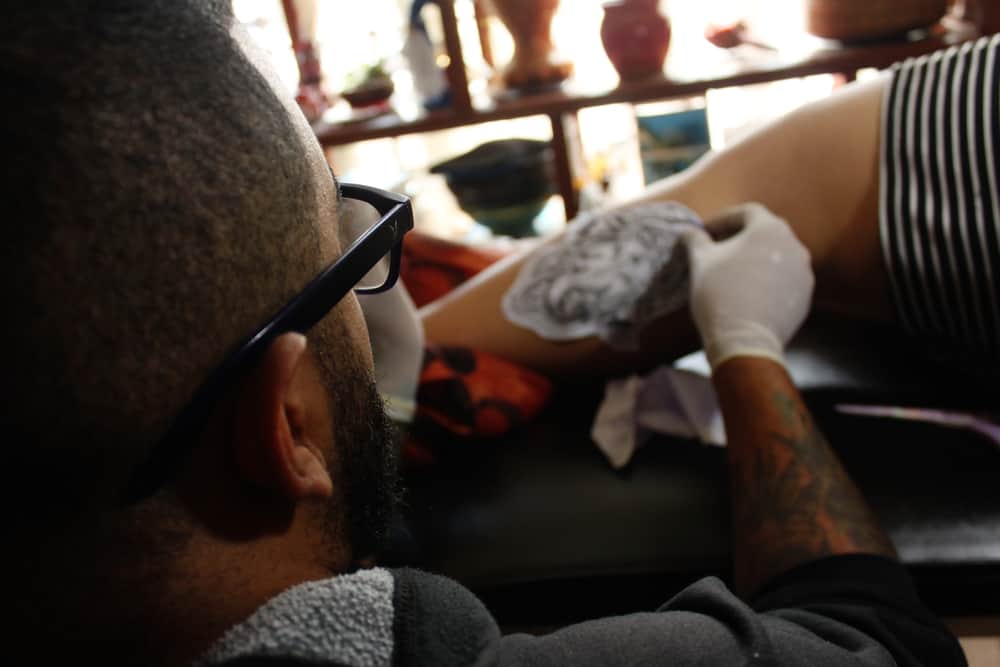
Can You Work Out After Getting A Calf Tattoo?
Working out after getting a calf tattoo is not a good idea. You’re encouraged to wait 48 hours for a small calf tattoo. Ideally, avoid strenuous exercise for a month or so until the tattoo is fully healed.
There are some critical reasons for avoiding working out after getting a tattoo:
- A newly-inked tattoo is an open wound with all the associated risks. Using dirty gym equipment, wiping your calf with a sweaty towel, or wearing tight fitness gear can cause a bacterial infection and damage your tattoo.
- Working out includes stretching, repeated movements, and muscular flexing. While your calf tattoo is in the first stage of healing, this motion can pull the skin, reopen the developing scab, and make the wound bleed and ooze. This delays the healing process.
- Rubbing your new tattoo against tight leggings or gym equipment is painful, irritating the wound and possibly introducing bacteria.
- Sweat prevents the calf tattoo from drying out, exposing it to infection. If you wear tight, sweaty clothes, healing will be hindered.
- Avoid swimming until the tattoo has healed.
- Stay out of the sun, and do gentle indoor activities rather than outdoor jogs.
Replace your workout routine with a walk or gentle jog so that you can heal and prevent infection. Focus on exercising other areas of the body until there is no pain or pulling.
Calf Tattoo Aftercare
Appropriate aftercare is essential for your calf tattoo to heal well so you can display your magnificent body art with pride.
Your artist will go through aftercare guidelines with you and recommend products to use on your tattoo. Follow these guidelines carefully until the tattoo is healed.
Here are aftercare recommendations that most tattoo artists provide:
- Boost healing by eating and drinking healthily in the first week after getting tattooed. Drink plenty of fluids and avoid salty foods to help reduce inflammation.
- Wash your hands before touching your new tattoo.
- Keep the tattoo open, without a bandage, as it needs to breathe and dry out.
- Use the balm, lotion, butter, or ointment your artist recommends throughout the healing process. These products speed up healing, numb the irritation, prevent itching, and allow the new skin to grow evenly, showcasing your tattoo at its best. Continual dryness and flaking will leach pigment from the tattoo, making it heal without the bright color.
- Keep the wound hydrated but breathing by applying only a meager layer of product at regular intervals. Moisturizing the tattoo maintains the color.
- Never scratch, fiddle with, or pull off flaky skin or scabs, however itchy or tempting. Your skin is healing and needs the protection of a scab or milky layer. You are potentially damaging the tattoo, creating scars, and risking infection via bacteria from under your fingernails.
- Avoid exposing the tattoo to the sun. Stay in the shade and wear protective clothing. Use sunscreen once you enter the final phase of healing.
- Do not immerse the new tattoo in water by swimming or bathing. Take a quick shower and gently pat the tattoo dry afterward. Once the milky layer develops, wash the tattoo with a specialized foaming cleanser, not scented soaps.
- Wear loose-fitting, comfortable trousers or skirts until your calf has healed.
- Avoid strenuous exercise for at least two days, preferably a couple of weeks.
- If you are concerned that your calf tattoo is infected or not healing correctly, see your tattoo artist, a doctor, or a health professional immediately. Besides the dangers an infection poses to your health, your tattoo will also be damaged, distorted, and discolored.
Awesome Calf Tattoo Designs (Instagram)
As you search for inspiration for your calf tattoo, scroll through these fantastic themes and examples that have been inked in incredible execution.
Tribal Designs
A popular style of tattoos with men, tribal tattoos often consist of strong black lines, geometric or undulating lines, and vivid patterns. Be sensitive to cultural appropriation of tribal designs that don’t form part of your heritage, as they may have religious or other symbolism:
Americana Designs
These are the classic designs you think of: hearts, arrows, scrolls, predatory animals, daggers, and anchors:
Japanese Designs
With their ancient history of tattoos, the Japanese pioneered a distinctive style that included color, linework, and symbolism.
Fine Line Designs
These tattoos encompass many themes, but are all characterized by intricate line work, usually in black:
Portraiture
Some of the most challenging tattoos, and portraits will require a photograph as a source image:
Animal Designs
Whether pets, wild animals, or your spirit animal, these realistic works of art are always popular for calf tattoos.
Flowery Designs
Designs involving flowers are always popular, whether feminine and colorful or with edgier components:
Cartoon Designs
These are fun designs, often with a personal story attached:
Biomechanical Designs
This fascinating style of tattoos “reveals” machinery hidden under your skin:
Conclusion
Having a tattoo on your calf is a great idea, but it’s essential to research what is involved, from the risks to the costs and from possible artists to attractive designs.
Resources
- https://authoritytattoo.com/getting-a-tattoo/
- https://www.byrdie.com/why-are-tattoos-popular-3189518
- https://www.gq-magazine.co.uk/article/leg-tattoos-for-men
- https://www.healthline.com/health/body-modification/pain-tattoos-chart
- https://www.healthline.com/health/working-out-after-tattoo
- https://www.huffpost.com/entry/psychology-of-tattoos_b_2017530
- https://www.nylon.com/beauty/tattoo-placement-affect-on-spiritual-energy
- https://www.savedtattoo.com/how-much-do-tattoos-cost/
- https://www.savedtattoo.com/wearing-clothes-over-a-new-tattoo/
- https://untamedscience.com/blog/the-psychology-of-tattoos-what-do-they-say-about-you/
- https://www.yahoo.com/lifestyle/tattoo-placement-says-personality-201225946.h


